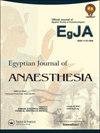腹部大手术患者的血流动力学监测及心电测量与食管多普勒的相关性
IF 0.5
Q3 ANESTHESIOLOGY
引用次数: 0
摘要
背景:经食管多普勒(TED)是一种微创监护仪,可以连续监测血流动力学变量。无创心电测量(EC)和TED方法增加了额外的设备来连续监测心输出量(CO)并指导液体管理。本研究的目的是在进行腹部大手术的病例中,将无创EC和食管多普勒(ED)的血流动力学监测联系起来。方法对35例美国麻醉医师学会(ASA)评定身体状况为II级或III级的成人腹部大手术患者进行前瞻性观察研究。对同一患者进行食管多普勒和食管超声检查。测量的参数为血流动力学参数。结果CO与ICON和ED的比较显示,ICON的平均值在5.6 ~ 6.2 l/min之间,ED的平均值在5.7 ~ 7.6 l/min之间,两者差异无统计学意义。ICON的精度为15.19 ~ 17.99%,ED的精度为13.39 ~ 17.08%。在ICON变化15%时,ED值的敏感性为72.6%,特异性为30.9%,AUC为0.505。结论EC测定的CO值与ED测定的CO值一致,是可以接受的。两者都监测趋势变化并指导手术室的液体管理。在腹部大手术中,EC与ED一样准确。本文章由计算机程序翻译,如有差异,请以英文原文为准。
Hemodynamic monitoring and correlation between electrical cardiometry and esophageal Doppler in patients undergoing major abdominal surgery
Background Transesophageal Doppler (TED) is a minimally invasive monitor that allows continuous hemodynamic variables monitoring. Non-invasive electrical cardiometry (EC) and TED methods added an additional facility to monitor cardiac output (CO) continuously and guide fluid management. The aim of this study was to correlate hemodynamic monitoring between non-invasive EC and Esophageal Doppler (ED) in cases undergoing major abdominal surgery.Methods This prospective observational study was carried out on 35 adult cases, American Society of Anesthesiologists (ASA) physical status II or III, undergoing major abdominal surgery. Esophageal Doppler and EC were attached to the same patient. Parameters measured were hemodynamic parameters.Results Comparison of CO with ICON and ED showed that the ICON mean value ranged from 5.6 to 6.2 l/min, and the ED mean value always ranged from 5.7 to 7.6 l/min with the non-significant difference between the two methods. The precision for the ICON ranged from 15.19 to 17.99% and the precision for ED ranged from 13.39 to 17.08%. At a 15% change in ICON, the ED values’ sensitivity was 72.6% and specificity was 30.9% with AUC 0.505.Conclusion The agreement between CO measured by EC and ED is acceptable. Both monitored trend changes and guided fluid administration in the operation theater. The EC is as accurate as ED in measuring hemodynamics during major abdominal surgery.
求助全文
通过发布文献求助,成功后即可免费获取论文全文。
去求助
来源期刊

Egyptian Journal of Anaesthesia
Medicine-Anesthesiology and Pain Medicine
CiteScore
0.90
自引率
0.00%
发文量
78
 求助内容:
求助内容: 应助结果提醒方式:
应助结果提醒方式:


